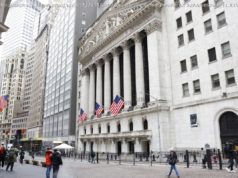Resilience on the Big Board leads market commentary.
The S&P 500 Index rose to its highest since mid-March on Monday, which is pretty remarkable considering all the headlines warning of a burgeoning global trade war, with even the U. S.’s closest allies threatening retaliatory measures unless President Donald Trump reverses course.
Most pundits pointed to optimism for economic growth as the reason behind the resilience in stocks, despite the trade alarms. But that analysis feels less than satisfying, mainly because economists generally agree that a trade war — or even a skirmish — is at best misguided and at worst risks pushing the economy into a period of slow growth and high inflation, or «stagflation.» Call it complacency, but perhaps the best explanation is that investors are betting that cooler heads will prevail. It’s not as crazy a theory as it sounds, given the Trump administration’s reputation for seat-of-the-pants decision-making. Nicholas Colas, co-founder of DataTrek, describes it as a sort of «trade policy put.» In other words, Trump has often equated a rising equities market as a ratification of his policies, and he’ll soften his protectionist trade plans on any sign they are proving detrimental to stock prices ahead of the midterm elections.
«Almost like the concept of a ‘Fed put,’ there is an implicit ‘trade policy put’ on current rhetoric, no matter how harsh,» Colas wrote in a research note Monday. «If all the jawboning starts to hurt U. S. business/consumer confidence or equity prices, markets expect President Trump to back away in the proverbial ‘New York minute.'» That’s not the only factor at play with stocks. Colas points to a rebound in shares of technology companies, a drop in market interest rates in recent weeks and the relative strength of the U. S. economy versus the euro zone and export-driven Asian countries.
TREASURY TIME The fallout from the strong Friday U. S. jobs report continued to weigh on the bond market, with yields on 10-year Treasuries rising for a fourth straight day. Even so, at 2.93 percent, yields remain comfortably below the psychologically important 3 percent level that many pundits say would be a headwind to the economy and riskier assets. But in a sign of growing nervousness about the future health of the economy, recent data show that bond dealers and commercial banks have been loading up on super-safe Treasuries. The Federal Reserve Bank of New York said Thursday that the 23 primary dealers of U. S. government securities hold $141.9 billion of Treasuries, the third-most in data going back to 1997 and the most since October 2013, shortly before the market went on a long rally that saw 10-year yields drop from 3 percent to less than 1.50 percent in mid-2016. Then on Friday, the Federal Reserve said commercial banks in the U. S. boosted their holdings of Treasuries and government-related debt to $2.52 trillion, the most since the start of January. It’s worth noting that the difference between two- and 10-year Treasury yields continues to narrow, shrinking to 42.6 basis points on Monday, resulting in the flattest so-called yield curve since 2007. It’s a trend that typically augers an economic slowdown. In its latest quarterly survey released Monday, the National Association for Business Economics said its members expect the economy to do fine this year, expanding at 2.8 percent — but 82 percent worry that the U. S. could enter a recession after 2019.
CURRENCY SIGNALS Some strategists are worried that the dollar’s recent performance may be reflecting the viewpoint expressed by the NABE’s members. They note that the greenback has been unable to mount any sustained appreciation despite some good U. S. economic data over the last two weeks week. The Bloomberg Dollar Spot Index fell Monday, giving up a good chunk of its gains from Friday following the strong monthly jobs reports and leaving it little changed from its level on March 18. Perhaps currency traders feel that this will be as good as it gets for the U. S. economy, given the heightened risk of a trade war with its allies. «Investors already accept that the U. S. economy appears to have accelerated (this quarter), but the kind of sustained growth that administration officials suggested and assumed — 3.0 (percent to) 4.0 (percent) — remains elusive,» Marc Chandler, Brown Brothers Harriman’s head of currency strategy, wrote in a research note Monday. «Many, including ourselves, are watching late-cycle evidence accumulate.» Compounding the headwinds for the dollar is that the fact that June is typically a bad month for the currency. The Bloomberg Dollar Spot Index has declined during June in eight out of the past 10 years, according to Bloomberg News’s Alexandria Arnold. So, with the dollar struggling, which currencies are benefiting? The Australian and New Zealand dollars have been particularly strong the past two weeks, appreciating 3.62 percent and 1.73 percent, respectively, against a basket of major peers. The yen has also gained, rising 0.82 percent, which is notable since the currency typically rallies in times of turmoil.
CRUMPLING COMMODITIES Unlike their peers in the stock market, commodities investors seem to be siding with the bond market and dollar traders in not being as sanguine about the potential for a moderation in the trade-war threats. The Bloomberg Commodity Index, which tracks returns for 22 components, fell as much as 1.15 percent to 89.409 on Monday in its biggest decline since March 7. The gauge is now 2.8 percent below its year-to-date high reached on May 24. Although the big drop in oil prices to below $65 a barrel from as high as about $73 just two weeks ago has garnered the most attention, the weakness in raw materials has been broad-based. On Monday, agricultural products were the big losers on concern that the trade spat, especially between the U. S. and China, could cut demand for farm goods. Raw sugar led the drop, falling as much as 5.3 percent, while wheat and corn were the next biggest losers, according to Bloomberg News’s Marvin G. Perez and Megan Durisin. In comments posted on Twitter on Monday, Trump blamed countries including Mexico, Canada and China for treating farmers «unfairly» and said he plans to end «big trade barriers.» The Bloomberg Commodity Index rose in both April and May, partly bolstered by strong crude prices. But the recent slide for oil amid speculation that OPEC and allied oil producers are moving closer to relaxing historic production caps has added to disappointment for investors who were betting an inflationary environment would lift prices for raw materials.
EMERGING MARKETS BOUNCE BACK The MSCI Emerging Markets Index of equities rose for a third straight day Monday, soaring as much as 1.54 percent in its biggest gain since early March amid signs that developing economies might just be able to sidestep the trade tiff enveloping major economies. MSCI’s gauge of emerging-market currencies rose the most in almost two weeks. Emerging markets are enjoying surging trade growth even as their developed peers experience cooling demand, according to a gauge produced by LogIndex AG, part of logistics giant Kuehne + Nagel Group AG.






